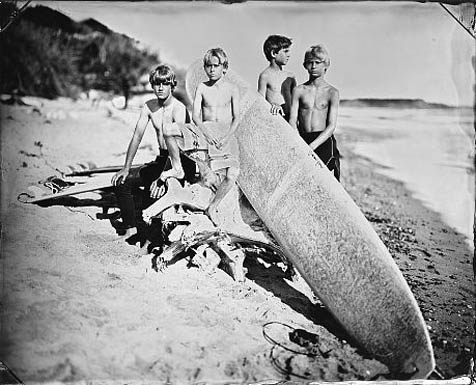New Photographs of Paintings by David Florimbi and SurfLand by Joni Sternbach.
At Edward Cella Art + Architecture. Shows through December 30.

As varied and expressive as the moods of the ocean are the personalities and purposes of the men and women who ride her waves. In a fabulous and occasionally brilliant rendering of this variety, Edward Cella Art + Architecture offers up two separate collections of anything but traditional photographs. From the haunting and confidence-dripping contrasts of Joni Sternbach’s black-and-white portraits to the wave-minded, dreamlike, and pixelated waterscapes of David Florimbi, the show is a bizarrely enjoyable mash-up of fundamental surf themes and cutting-edge photographic approaches.
Sternbach’s SurfLand series reveals the faces and feelings of board riders of all shapes, sizes, and ages. Using a unique, tintype format, Sternbach poses surfers standing in their world-either on the sand or in the shallows of the ocean-the stark sheen of her timeless images freezing their gazes of awe, hope, joy, and determination. With the waves of Montauk (Long Island), Malibu, and our very own Rincon as their backdrop, her 13 photos with simple names like “Kristen,” “William (Rincon),” and “Four Brothers and board” capture the range of feelings a surfer experiences when facing the ocean. The series is a gritty celebration of a salt-flavored life where the line between the individual and the masses, the old and the new, is beautifully blurred.
For his part, David Florimbi tackles the realm of the ridden and the unridden with four deeply textured acrylic and resin paintings of abstract and up-close wave views and eight larger chromogenic prints of similar perspectives. Brightly awash in every hue of blue possible, Florimbi’s work is reminiscent of George Greenough’s now famous water-speckled tube views of the late 1970s-woozy and dreamlike while also undoubtedly realistic. In a complex dance of creation, Florimbi photographs moving images of waves from a television screen, paints over the photograph in oils, then films the now-duplicated image, replaying and once again photographing the film of the painting. Finally, he paints yet another rendering on top of the photographed film, and takes one final photograph that is blown up and printed on a diasec mount. The process fills the image with air, life, and motion, all of which translate perfectly to the medium of ocean.



